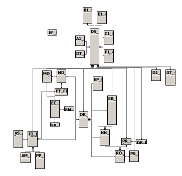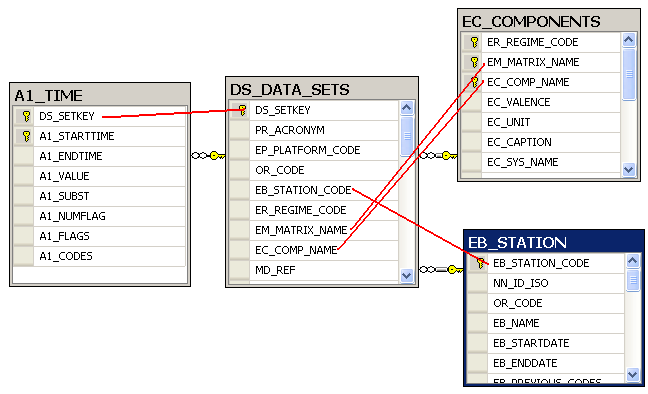Difference between revisions of "Encoding Relational Tables in NetCDF"
| Line 179: | Line 179: | ||
=== NILU / EBAS === | === NILU / EBAS === | ||
| − | The EBAS database schema is rather large, | + | The EBAS database schema is rather large, full schema outline looks like this: |
[[Image:EBAS_thumbnail.png]] | [[Image:EBAS_thumbnail.png]] | ||
| − | |||
| − | + | The essential schema is not that big, only four tables. | |
| − | |||
| − | |||
| − | |||
| − | |||
| − | |||
| − | |||
| − | |||
| − | |||
[[Image:EBAS_essential.png]] | [[Image:EBAS_essential.png]] | ||
| Line 199: | Line 190: | ||
The essential four tables are: | The essential four tables are: | ||
| − | * EB_STATION: This contains the station information EB_STATION. | + | * EB_STATION: This contains the station information EB_STATION. |
| − | + | ** EB_STATION_CODE is the unique code. | |
| − | + | ** lat, lon, alt; some miscellaneous fields about the history of the station. | |
| − | |||
| − | |||
| − | + | * EC_COMPONENTS: This table contains the measured parameters. Fields '''EM_MATRIX_NAME''' and '''EC_COMP_NAME''' define what is being measured. | |
| − | + | ** EM_MATRIX_NAME defines which medium the parameter is measured in (e.g. precipitation, air, pm10, ...) | |
| − | + | ** EC_COMP_NAME is the name of the parameter (e.g. sulphate_total, ...) | |
| − | + | ** Various other fields, like '''EC_UNIT''' define more metadata. | |
| − | |||
| − | |||
| + | * DS_DATA_SET: | ||
| + | ** Table DS_DATA_SET describes what is called a '''dataset''' in '''EBAS''': One parameter measured at a certain station. The full version has some more complex dependecies on instrument, method etc. | ||
| + | ** The columns EM_MATRIX_NAME and EC_COMP_NAME refer to the EC_COMPONENTS table. | ||
| + | ** DS_STARTDATE and DS_ENDDATE provide the timestamp of the first and last measurement in the timeseries. | ||
| + | ** There are many other fields and references to many other tables. | ||
| − | + | You can imagine a dataset as an instrument on a fixed location measuring one parameter. This leads us to the main data table. | |
| − | |||
| − | |||
| − | |||
| − | |||
| − | + | * Table A1_TIME Contains all the observations, all the parameters from all the stations | |
| + | ** DS_SETKEY refers to the dataset. | ||
| + | ** A1_STARTTIME and A1_ENDTIME define the measurement time. | ||
| + | ** A1_VALUE contains the data value | ||
| + | ** The rest of the fields are metadata. | ||
Revision as of 12:25, August 31, 2011
Back to Questions and Comments about CF-1.6 Station Data Convention
Rational Behind this Proposal
The WCS service has potential to grow beyond regular, gridded coverages. Coverage types that need to be described are for example:
- station point data
- station trajectory data
- lidar data
- moving station data, like aeroplane or ship
With a relational system, it is easy to design a schema that captures all the data and the metadata.
The netCDF data format was designed to contain mainly gridded multidimensional data. The format does not have a special support for tables, which sounds like a severe restriction, but it's not.
- It's possible to agree about a simple way to encode tables in a netCDF file.
- Tables with multiple fields.
- Proper primary keys for tables.
- Foreign keys for referential integrity.
- Common relationships: many-to-many, 1-to-many, 1-to-1.
- It's possible to be efficient, the encoding does not have to be one size fits all.
- Sparse tables can be encoded row-by-row manner.
- Dense tables can be encoded as multidimensional hypercubes.
- Mix and match the two above at will.
- It's possible to be elegant.
- No mysterious indirections.
- No complex offset calculations.
- A reader-writer library can take care of following the rules, letting a programmer to operate on higher level.
Encoding Table Columns
Table is a collection of columns. These are indicated with table_name attribute.
Every table needs a primary key. It is indicated with primary_key = "T" attribute.
Example: A station table with three columns: station_code, lat and lon. There are ten rows with indexes 0..9
dimensions:
station = 10 ; // station table dimension
station_code_length = 4 ; // artificial dimension for station code, with max four character length.
variables:
char station_code(station, station_code_length) ;
station_code:table_name = "station";
station_code:primary_key = "T";
float lon(station) ;
lon:table_name = "station";
float lat(station) ;
lat:table_name = "station";
The dimension name station can be anything. It does not have to equal the table name station, but should be for readability. Same for station_code_length, it can be called anything.
A table can have multiple fields as a primary key.
Encoding Multiple Tables
Adding the second table is similar. Since new data is usually added by time, it can be made the unlimited dimension.
dimensions:
station = 10 ; // station table dimension
station_code_length = 4 ; // artificial dimension for station code, with max four character length.
time = UNLIMITED ;
variables:
char station_code(station, station_code_length) ;
station_code:table_name = "station";
station_code:primary_key = "T";
float lon(station) ;
lon:table_name = "station";
float lat(station) ;
lat:table_name = "station";
int time(time) ;
time:table_name = "time";
time:primary_key = "T";
Encoding Relations
A typical station data instance is a relation (station_code, time, temperature, humidity). The pair (station_code, time) is the primary key; data is recorded at a certain station, at a certain time. Temperature and humidity are the recorded parameters.
Encoding this into netCDF can be done in two ways, using either variable or a dimension.
Encoding Relation as a Record Array
So far we have the two unrelated tables for our two dimensions: location and time. Now let's add humidity and temperature, which refers to both of the dimensions:
dimensions:
station = 10 ; // station table dimension
station_code_length = 4 ; // artificial dimension for station code, with max four character length.
data = UNLIMITED // each row in the data table.
time = 2000 ; we can't have two unlimited dimensions.
variables:
char station_code(station, station_code_length) ;
station_code:table_name = "station";
station_code:primary_key = "T";
float lon(station) ;
lon:table_name = "station";
float lat(station) ;
lat:table_name = "station";
int time(time) ;
time:table_name = "time";
time:primary_key = "T";
int data_station_code(data) ;
data_station_code:table_name = "data";
data_station_code:foreign_key = "station_code";
data_station_code:primary_key = "T";
int data_time(data) ;
data_time:table_name = "data";
data_time:foreign_key = "time";
data_time:primary_key = "T";
float temperature(data) ;
temperature:table_name = "data";
float humidity(data) ;
humidity:table_name = "data";
The variable data_station_code is marked foreign_key = "station_code", which means, that the variable is an index to the station_code variable. Similar for time. Both are marked primary_key = "T" which means, that the combination of (data_station_code, data_time) is unique.
To read the full table (station_code, lat, lon, time, temperature, humidity), row by row:
for idx in range of data
read station:
read data_station_code(idx)
read variables station_code, lat and lon at that index
read time:
read data_time(idx)
read variable time at that index
read temperature(idx)
read humidity(idx)
This is an space-efficient encoding for sparse tables.
Encoding Relation as a Multidimensional Array
This is identical to CF-1.6 encoding. Both variables are 2-dimensional cubes.
dimensions:
station = 10 ; // station table dimension
station_code_length = 4 ; // artificial dimension for station code, with max four character length.
time = UNLIMITED ; // we can again add one time slice at a time
variables:
char station_code(station, station_code_length) ;
station_code:table_name = "station";
station_code:primary_key = "T";
float lon(station) ;
lon:table_name = "station";
float lat(station) ;
lat:table_name = "station";
int time(time) ;
time:table_name = "time";
time:primary_key = "T";
float temperature(time,station) ;
temperature:table_name = "data";
float humidity(time,station) ;
humidity:table_name = "data";
This declares two arrays, one for temperature and one for humidity. Both are two-dimensional. The dimensions time and station refer to the time and station variables. They implicitly became part of the primary key.
To find temperature at "ACAD" in "2004-17-22":
Find index for "ACAD" from the "station_code" array. Let's say it's 2.
Find index for "2004-17-22" from the time array. Lets say it's 317.
Read temperature(317,2)
This is a very space-efficient encoding, if most of the stations have data most of the time.
Summa Summarum
- A typical schema of any relational database can be encoded.
- If the data is sparse, foreign keys can be expressed as variables.
- If the data is dense, foreign keys can be expressed as dimensions, resulting in vastly smaller files than flat CSV would be.
- There can be any combination of the two, enabling the best of both worlds whatever your data will look like.
More Real World Examples
These examples are not full real-life examples of real live databases, but rather examples how to encode a typical schema. The center is usually the data table, and the data record refers to the auxliary metadata tables. Typically cases are a star or a snowflake schema.
CIRA / VIEWS
All the data is stored at the center table AirData3. The
NILU / EBAS
The EBAS database schema is rather large, full schema outline looks like this:
The essential schema is not that big, only four tables.
The essential four tables are:
- EB_STATION: This contains the station information EB_STATION.
- EB_STATION_CODE is the unique code.
- lat, lon, alt; some miscellaneous fields about the history of the station.
- EC_COMPONENTS: This table contains the measured parameters. Fields EM_MATRIX_NAME and EC_COMP_NAME define what is being measured.
- EM_MATRIX_NAME defines which medium the parameter is measured in (e.g. precipitation, air, pm10, ...)
- EC_COMP_NAME is the name of the parameter (e.g. sulphate_total, ...)
- Various other fields, like EC_UNIT define more metadata.
- DS_DATA_SET:
- Table DS_DATA_SET describes what is called a dataset in EBAS: One parameter measured at a certain station. The full version has some more complex dependecies on instrument, method etc.
- The columns EM_MATRIX_NAME and EC_COMP_NAME refer to the EC_COMPONENTS table.
- DS_STARTDATE and DS_ENDDATE provide the timestamp of the first and last measurement in the timeseries.
- There are many other fields and references to many other tables.
You can imagine a dataset as an instrument on a fixed location measuring one parameter. This leads us to the main data table.
- Table A1_TIME Contains all the observations, all the parameters from all the stations
- DS_SETKEY refers to the dataset.
- A1_STARTTIME and A1_ENDTIME define the measurement time.
- A1_VALUE contains the data value
- The rest of the fields are metadata.

